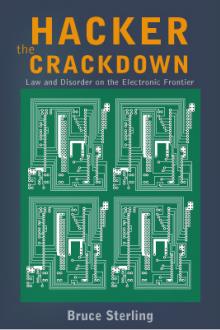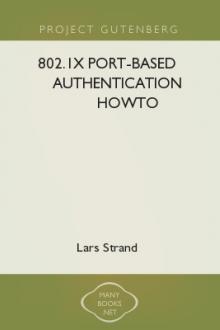Hacker Crackdown by Bruce Sterling (the reader ebook txt) 📖

- Author: Bruce Sterling
- Performer: 055356370X
Book online «Hacker Crackdown by Bruce Sterling (the reader ebook txt) 📖». Author Bruce Sterling
So the Secret Service’s authority over “unauthorized access” to computers covers a lot of territory, but by no means the whole ball of cyberspatial wax. If you are, for instance, a LOCAL computer retailer, or the owner of a LOCAL bulletin board system, then a malicious LOCAL intruder can break in, crash your system, trash your files and scatter viruses, and the U.S. Secret Service cannot do a single thing about it.
At least, it can’t do anything DIRECTLY. But the Secret Service will do plenty to help the local people who can.
The FBI may have dealt itself an ace off the bottom of the deck when it comes to Section 1030; but that’s not the whole story; that’s not the street. What’s Congress thinks is one thing, and Congress has been known to change its mind. The REAL turf-struggle is out there in the streets where it’s happening. If you’re a local street-cop with a computer problem, the Secret Service wants you to know where you can find the real expertise. While the Bureau crowd are off having their favorite shoes polished—(wing-tips)—and making derisive fun of the Service’s favorite shoes—(“pansy-ass tassels”)—the tassel-toting Secret Service has a crew of ready-and-able hacker-trackers installed in the capital of every state in the Union. Need advice? They’ll give you advice, or at least point you in the right direction. Need training? They can see to that, too.
If you’re a local cop and you call in the FBI, the FBI (as is widely and slanderously rumored) will order you around like a coolie, take all the credit for your busts, and mop up every possible scrap of reflected glory. The Secret Service, on the other hand, doesn’t brag a lot. They’re the quiet types. VERY quiet. Very cool. Efficient. High-tech. Mirrorshades, icy stares, radio ear-plugs, an Uzi machine-pistol tucked somewhere in that well-cut jacket. American samurai, sworn to give their lives to protect our President. “The granite agents.” Trained in martial arts, absolutely fearless. Every single one of ‘em has a top-secret security clearance. Something goes a little wrong, you’re not gonna hear any whining and moaning and political buck-passing out of these guys.
The facade of the granite agent is not, of course, the reality. Secret Service agents are human beings. And the real glory in Service work is not in battling computer crime—not yet, anyway—but in protecting the President. The real glamour of Secret Service work is in the White House Detail. If you’re at the President’s side, then the kids and the wife see you on television; you rub shoulders with the most powerful people in the world. That’s the real heart of Service work, the number one priority. More than one computer investigation has stopped dead in the water when Service agents vanished at the President’s need.
There’s romance in the work of the Service. The intimate access to circles of great power; the esprit-de-corps of a highly trained and disciplined elite; the high responsibility of defending the Chief Executive; the fulfillment of a patriotic duty. And as police work goes, the pay’s not bad. But there’s squalor in Service work, too. You may get spat upon by protesters howling abuse—and if they get violent, if they get too close, sometimes you have to knock one of them down— discreetly.
The real squalor in Service work is drudgery such as “the quarterlies,” traipsing out four times a year, year in, year out, to interview the various pathetic wretches, many of them in prisons and asylums, who have seen fit to threaten the President’s life. And then there’s the grinding stress of searching all those faces in the endless bustling crowds, looking for hatred, looking for psychosis, looking for the tight, nervous face of an Arthur Bremer, a Squeaky Fromme, a Lee Harvey Oswald. It’s watching all those grasping, waving hands for sudden movements, while your ears strain at your radio headphone for the long-rehearsed cry of “Gun!”
It’s poring, in grinding detail, over the biographies of every rotten loser who ever shot at a President. It’s the unsung work of the Protective Research Section, who study scrawled, anonymous death threats with all the meticulous tools of anti-forgery techniques.
And it’s maintaining the hefty computerized files on anyone who ever threatened the President’s life. Civil libertarians have become increasingly concerned at the Government’s use of computer files to track American citizens— but the Secret Service file of potential Presidential assassins, which has upward of twenty thousand names, rarely causes a peep of protest. If you EVER state that you intend to kill the President, the Secret Service will want to know and record who you are, where you are, what you are, and what you’re up to. If you’re a serious threat—if you’re officially considered “of protective interest”—then the Secret Service may well keep tabs on you for the rest of your natural life.
Protecting the President has first call on all the Service’s resources. But there’s a lot more to the Service’s traditions and history than standing guard outside the Oval Office.
The Secret Service is the nation’s oldest general federal law-enforcement agency. Compared to the Secret Service, the FBI are new-hires and the CIA are temps. The Secret Service was founded ‘way back in 1865, at the suggestion of Hugh McCulloch, Abraham Lincoln’s Secretary of the Treasury. McCulloch wanted a specialized Treasury police to combat counterfeiting. Abraham Lincoln agreed that this seemed a good idea, and, with a terrible irony, Abraham Lincoln was shot that very night by John Wilkes Booth.
The Secret Service originally had nothing to do with protecting Presidents. They didn’t take this on as a regular assignment until after the Garfield assassination in 1881. And they didn’t get any Congressional money for it until President McKinley was shot in 1901. The Service was originally designed for one purpose: destroying counterfeiters.
There are interesting parallels between the Service’s nineteenth-century entry into counterfeiting, and America’s twentieth-century entry into computer-crime.
In 1865, America’s paper currency was a terrible muddle. Security was drastically bad. Currency was printed on the spot by local banks in literally hundreds of different designs. No one really knew what the heck a dollar bill was supposed to look like. Bogus bills passed easily. If some joker told you that a one-dollar bill from the Railroad Bank of Lowell, Massachusetts had a woman leaning on a shield, with a locomotive, a cornucopia, a compass, various agricultural implements, a railroad bridge, and some factories, then you pretty much had to take his word for it. (And in fact he was telling the truth!)
SIXTEEN HUNDRED local American banks designed and printed their own paper currency, and there were no general standards for security. Like a badly guarded node in a computer network, badly designed bills were easy to fake, and posed a security hazard for the entire monetary system.
No one knew the exact extent of the threat to the currency. There were panicked estimates that as much as a third of the entire national currency was faked. Counterfeiters—known as “boodlers” in the underground slang of the time—were mostly technically skilled printers who had gone to the bad. Many had once worked printing legitimate currency. Boodlers operated in rings and gangs. Technical experts engraved the bogus plates— commonly in basements in New York City. Smooth confidence men passed large wads of high-quality, high-denomination fakes, including the really sophisticated stuff—government bonds, stock certificates, and railway shares. Cheaper, botched fakes were sold or sharewared to low-level gangs of boodler wannabes. (The really cheesy lowlife boodlers merely upgraded real bills by altering face values, changing ones to fives, tens to hundreds, and so on.)
The techniques of boodling were little-known and regarded with a certain awe by the mid-nineteenth-century public. The ability to manipulate the system for rip-off seemed diabolically clever. As the skill and daring of the boodlers increased, the situation became intolerable. The federal government stepped in, and began offering its own federal currency, which was printed in fancy green ink, but only on the back—the original “greenbacks.” And at first, the improved security of the well-designed, well-printed federal greenbacks seemed to solve the problem; but then the counterfeiters caught on. Within a few years things were worse than ever: a CENTRALIZED system where ALL security was bad!
The local police were helpless. The Government tried offering blood money to potential informants, but this met with little success. Banks, plagued by boodling, gave up hope of police help and hired private security men instead. Merchants and bankers queued up by the thousands to buy privately-printed manuals on currency security, slim little books like Laban Heath’s INFALLIBLE GOVERNMENT COUNTERFEIT DETECTOR. The back of the book offered Laban Heath’s patent microscope for five bucks.
Then the Secret Service entered the picture. The first agents were a rough and ready crew. Their chief was one William P. Wood, a former guerilla in the Mexican War who’d won a reputation busting contractor fraudsters for the War Department during the Civil War. Wood, who was also Keeper of the Capital Prison, had a sideline as a counterfeiting expert, bagging boodlers for the federal bounty money.
Wood was named Chief of the new Secret Service in July 1865. There were only ten Secret Service agents in all: Wood himself, a handful who’d worked for him in the War Department, and a few former private investigators—counterfeiting experts— whom Wood had won over to public service. (The Secret Service of 1865 was much the size of the Chicago Computer Fraud Task Force or the Arizona Racketeering Unit of 1990.) These ten “Operatives” had an additional twenty or so “Assistant Operatives” and “Informants.” Besides salary and per diem, each Secret Service employee received a whopping twenty-five dollars for each boodler he captured.
Wood himself publicly estimated that at least HALF of America’s currency was counterfeit, a perhaps pardonable perception. Within a year the Secret Service had arrested over 200 counterfeiters. They busted about two hundred boodlers a year for four years straight.
Wood attributed his success to travelling fast and light, hitting the bad-guys hard, and avoiding bureaucratic baggage. “Because my raids were made without military escort and I did not ask the assistance of state officers, I surprised the professional counterfeiter.”
Wood’s social message to the once-impudent boodlers bore an eerie ring of Sundevil: “It was also my purpose to convince such characters that it would no longer be healthy for them to ply their vocation without being handled roughly, a fact they soon discovered.”
William P. Wood, the Secret Service’s guerilla pioneer, did not end well. He succumbed to the lure of aiming for the really big score. The notorious Brockway Gang of New York City, headed by William E. Brockway, the “King of the Counterfeiters,” had forged a number of government bonds. They’d passed these brilliant fakes on the prestigious Wall Street investment firm of Jay Cooke and Company. The Cooke firm were frantic and offered a huge reward for the forgers’ plates.
Laboring diligently, Wood confiscated the plates (though not Mr. Brockway) and claimed the reward. But the Cooke company treacherously reneged. Wood got involved in a down-and-dirty lawsuit with the Cooke capitalists. Wood’s boss, Secretary of the Treasury McCulloch, felt that Wood’s demands for money and glory were unseemly, and even when the reward money finally came through, McCulloch refused to pay Wood anything. Wood found himself mired in a seemingly endless round of federal suits and Congressional lobbying.
Wood never got his money. And he lost his job to boot. He resigned in 1869.
Wood’s agents suffered, too. On May 12, 1869, the second Chief of the Secret Service took over, and almost immediately fired most of Wood’s pioneer Secret Service agents: Operatives, Assistants and Informants alike. The practice of receiving $25





Comments (0)